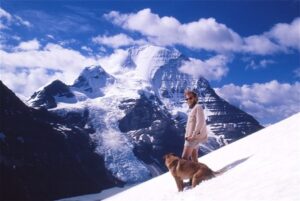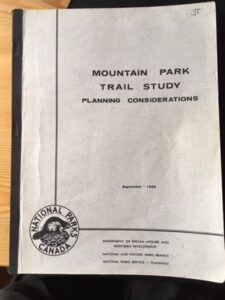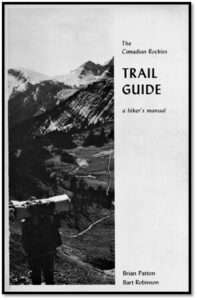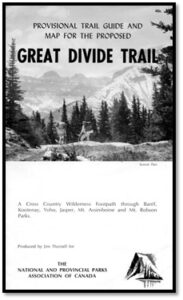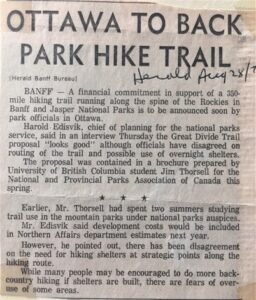By Jenny L. Feick, PhD
Chapter Two of Tales from the Great Divide, Vignettes on the Origins and Early History of Canada’s Great Divide Trail reveals the sources of the Great Divide Trail concept. It focuses on the pioneering work that established the vision for the GDT and that inspired and guided others to explore the idea and make it a reality. This chapter presents the recollections of Dr. James (Jim) Thorsell (affectionately nicknamed “Thor”) about his work during the 1960s and 1970s to initiate and promote the GDT concept in the Canadian mountain national parks in Alberta and British Columbia. Here is an excerpt from the Second Edition of Tales from the Great Divide that honours Thor’s vision and early survey work for a GDT route through Canada’s mountain parks.
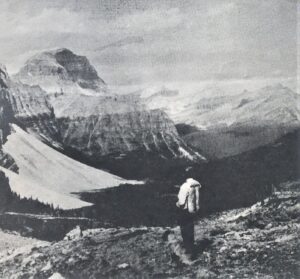
When and how did you first think about the concept of a hiking trail along the continental divide in Canada? What (and/or who) inspired you?
“I should mention that, in the beginning, about the same time as I started working at Parks in ’62, there were several individuals and groups that had suggested, in a much smaller forum and not in any official capacity, of a possibility of the trail going north from Banff or Lake Louise [See the Detailed Timeline in Appendix A]. So, things were starting to happen and starting to get assembled.
“And it occurred to me, after a summer of hiking [in the Lake Louise area in 1962, and especially in 1963], that we had a longitudinal geography here, with the [potential for a] trail going north and south.
“Also, [in] that summer [of 1965], I ended up working in Waterton [Lakes] National Park on my Master’s thesis, and part of my study down there was to look at the trail system in Waterton. That was a great summer and warmup for the [Great Divide Trail] GDT [work that began] in ’72.
“I then moved on to the headquarters of Parks Canada in Ottawa, where I was assigned as a researcher and planner. And I suggested that, when I gave them my report on the trails in Waterton, I suggested to the Director there that, “Why don’t we do something like that for Banff, Jasper, Yoho, [and] Kootenay [national parks]?” He agreed. I said, “That’s great. When do I leave?”
“I then started this major two‑year study of the feasibility of a Great Divide Trail through the Rockies [1968/69]. The initial stage was from [Mount] Assiniboine to [Mount] Robson. It was two years of fieldwork I spent doing backpacking trips and looking for the best routes and going on a lot of horse trips with the wardens in their different districts and so on.
“I did have one assistant on that whole study, Jim Green. He was a guy from Pincher Creek, and he was a good outdoor backpacker and he helped me do a lot of the interviews with people who were out hiking trails and filling in information on where they’re from and what do they think of the park trails and things like that. He was a handy guy to have with me on this trip, and he accompanied me on many of the backpacks.
“I had a great two summers walking back and forth between [Mount] Robson and [Mount] Assiniboine, and they were really special experiences for me, with all the things that go on a backpacking trip and all the wildlife and everything we saw, including [mountain] caribou and wolverines and so on.”
How did those first thoughts evolve into the proposal you made to Parks Canada for a Great Divide Trail?
“So, the trail survey turned into quite a major report. It was a formal report to Parks Canada. It was about 80 or 90 pages long where I did a detailed proposal for the Great Divide Trail … They then hired me again that next summer [1970] where I refined the whole route and did another report on the potential management issues that the trail would face.
“I think it was the report that I did, with lots of photos, lots of public relations and promotion of the concept. And it was a formal proposal. Parks [Canada] endorsed it as something that they were going to do, and I was delighted that they were going to go ahead with it.”
What work did you do to promote the concept of a Great Divide Trail and your proposal in particular? Can you share some of the highlights and challenges? Who helped you?
“I was doing a lot of promotion of the GDT proposal. I was giving slide shows here in [Banff] town at the Whyte [Museum] and another one up in Jasper and a couple others in Calgary and Edmonton, and so on. I wrote lots of articles about the potential of having the Great Divide Trail contiguous from north to south in the Rockies.
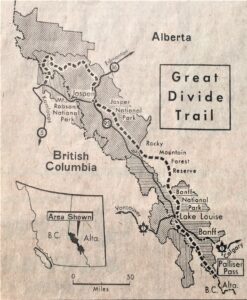
“At the same time, I started leading hikes for people, up to ten‑day hikes, on the Great Divide Trail and getting a lot of influential people going on those hikes and supporting the whole idea. At the same time, I got the authors on the Canadian Rockies Trail Guide [Brian Patton and Bart Robinson]. That was one of the recommendations in my report, that somebody write a trail guide to the Rockies.
“So, Brian Patton and Bart Robinson wrote that trail guide, and I wrote a trail guide myself as well[1]. It was a fold‑out one, the initial one, that people could buy for 40 cents. And they ended up putting that in the first five issues of the trail guide, which then gave the Great Divide Trail a lot of publicity. And people started hiking it, even though it wasn’t quite ready.
“Then, towards the end of that summer [1970], suddenly there was a newspaper article came out that Jean Chretien, who was the Minister for Parks[2] [Canada] at the time, and he said he was announcing that Parks Canada was going to implement my proposal on the Great Divide Trail. And he was going to set aside funding, and he was quite excited about it.

“There were all sorts of newspaper articles and everything on it supporting what a great idea it was. In fact, I’ve got a scrapbook here of about 30 or 40 articles that came out in different newspapers and magazines and so on [See asterisked articles in Appendix C]. So, it looked like it was really rolling along at that point.”
Thor Continues To Amaze
In his 1969 proposal, Thor recommended investigating the feasibility of extending the Great Divide Trail from Banff National Park south to Waterton Lakes National Park. This captured the imagination of Cliff White in Banff, Alberta. Upon Thor’s return to Banff after finishing his interdisciplinary PhD in parks management at UBC, he learned that Cliff and five other young people[3] funded by a federal Opportunities for Youth grant would conduct that feasibility study for a GDT route between Banff and Waterton in 1974. He provided what support he could while working at the University of Alberta Forestry Program and applauded the establishment of the Great Divide Trail Association in 1976.
Three years later, Thor left Canada to work in East Africa. In 1983, he moved to Geneva, Switzerland, beginning a 23-year career with the United Nations World Heritage Sites Program, working in and/or visiting over 600 national parks. Although his career with the IUCN kept him abroad for many years, Thor returned as often as he could to hike in the Rockies. He kept in touch with Cliff White and me, periodically checking on the status of the GDT.
Back in the Canadian Rockies for his retirement, Thor was pleased to learn about the revival of the GDTA in 2013. At age 76, in 2016, he backpacked his favourite section of the GDT, the Rockwall in Kootenay National Park, BC. Thor contributed content and resources to the development of the first edition of Tales from the Great Divide and he and his wife Nancy Knechtel expressed delight to see the final product in the autumn of 2019. He continued to assist from time to time with the second edition of Tales during his wife’s illness and following her death in January 2020. In 2022, he gave me additional articles in case I do a 3rd edition.

During his retirement, Thor divided his time between three places he loves, Banff, Alberta, Wilmer, British Columbia, and Baja California, Mexico. Now, at 82-years old, he has decided to settle down in his beloved Banff. All of us who have experienced the joys and challenges of hiking the GDT owe him our sincere thanks for his pioneering proposal, his early work to inspire others to make the GDT vision a tangible reality, and his conservation work across the globe.
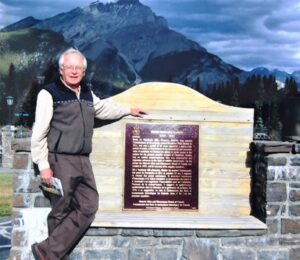
What is Tales from the Great Divide and How Can I Get a Copy?
Tales from the Great Divide, Vignettes on the Origins and Early History of Canada’s Great Divide Trail and Great Divide Trail Association is a self-published compendium of stories from individuals involved firsthand in the start and development of the GDT and the GDTA. First published in September 2019, Tales from the Great Divide brings to life the memories of many of the ‘originals’ whose vision, idealism, dedication, and hard work over five decades made Canada’s Great Divide Trail a reality. Transcripts of interviews and storytelling sessions, combined with excerpts from letters and other documents and hundreds of photographs and illustrations, reveal the adventurous, heartbreaking, and hilarious moments that characterized the early history of the GDT. Devising and establishing a route for this wilderness long-distance trail along the crest of the Canadian Rocky Mountains demonstrated naive courage and optimism. These pathfinders faced personal hardships and their trail work took place at a time before lightweight gear existed and without technological aids such as GPS, inReach, cell phones, or satellite phones. In their quest to establish the GDT with a protected corridor, they confronted numerous threats and challenges. The first edition is out of print but a pdf can be ordered from the Nature Wise Consulting website for $11.00.
The Second Edition of Tales from the Great Divide (416 pages, 300+ images) includes more than 100 pages of new material, over 100 additional images, and other enhancements. It also corrects errors found in the first edition after it was printed. The second edition was completed in 2021.
There are now five ways people can obtain a copy of the second edition of Tales from the Great Divide:
- Order a print-on-demand version from Amazon for Cdn $85.00 (rate in US$ varies with the exchange rate) plus shipping (free for Amazon Prime members).
- Purchase the book from one of the independent bookstores selling it (The Whyte Museum of the Canadian Rockies in Banff, Alberta, Crockett’s Trading Company in Bellevue, Alberta, Four Point Books in Invermere, B.C. Prices vary depending on the bookstore.
- Contact Geartrade, which operates the official GDTA online store. They sell the book for $80.00.
- Arrange to purchase a printed copy directly in person from Jenny Feick, the editor, in the Invermere area or Dave Higgins in Calgary for Cdn $65.00 (shipping anywhere in Canada would cost $20.00). To set this up, please email jenny.feick@gmail.com .
- Order a PDF version from the Nature Wise Consulting website for Cdn $25.00 – https://naturewise.me/consulting/product/tales-from-the-great-divide-second-edition/ .
[1] Editor’s Note: The first edition of the Canadian Rockies Trail Guide by Bart Robinson and Brian Patton was published in 1971 (see Appendix C). It and the subsequent five editions (published in 1978, 1986, 1990, 1992, 1994, 1995, and 2000) included a six-page summary of the Great Divide Trail concept and route written by Jim Thorsell.
[2] From 1968 until 1979, Parks Canada was one of three program areas within the Department of Indian Affairs and Northern Development (DIAND). Jean Chretien was the Minister of DIAND from 1968 to 1974 when he became President of the Treasury Board. (from Wikipedia)
[3] Jenny Feick, Mary Jane Cox, David Higgins, Dave Zevick, and Chris Hart joined Cliff White to carry out Project: Great Divide Trails in the summer of 1974. Their story is told in Chapter Three of Tales from the Great Divide.

